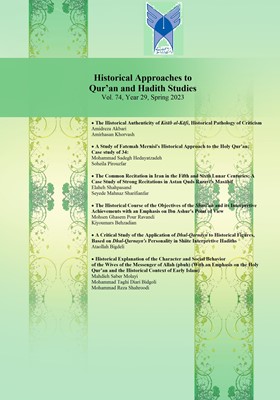-
-
List of Articles
-
Open Access Article
1 - The Historical Authenticity of Kitāb al-Kāfi, Historical Pathology of Criticism
Amidreza Akbari Amirhasan Khorvash -
Open Access Article
2 - Initial pages of the quarterly, certificate, writing criteria and list of articles
-
Open Access Article
3 - A Study of Fatemah Mernisi's Historical Approach to the Holy Qur'an; Case study of 34:4
mohammad sadegh hedayatzadeh Soheila Pirouzfar -
Open Access Article
4 - The Common Recitation in Iran in the Fifth and Sixth Lunar Centuries: A Case Study of Strong Recitations in Astan Quds Razavi's Masāḥif
Elaheh Shahpasand Seyede Mahnaz Sharifianfar -
Open Access Article
5 - The Historical Course of the Objectives of the Shari'ah and its Interpretive Achievements with an Emphasis on Ibn Ashur's Point of View
Mohsen Ghasem Pour Ravandi Kiyoumars Behzadian -
Open Access Article
6 - A Critical Study of the Application of Dhul-Qarnayn to Historical Figures, Based on Dhul-Qarnayn's Personality in Shiite Interpretive Hadiths
Ataollah Bigdeli -
Open Access Article
7 - Historical Explanation of the Character and Social Behavior of the Wives of the Messenger of Allah (pbuh) (With an Emphasis on the Holy Qur’an and the Historical Context of Early Islam)
mahdieh sabermolayi mohammad taghi diaribidgoli mohammad reza shahroodi -
Open Access Article
8 - English translations of journal article abstracts and journal ID in English
-
The rights to this website are owned by the Raimag Press Management System.
Copyright © 2021-2025







